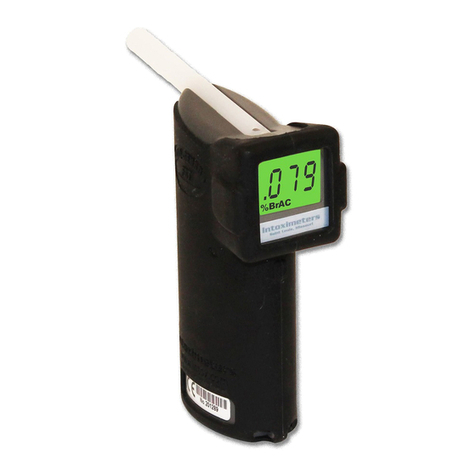ALCO-SENSOR FST® -9- OPERATOR’S MANUAL
2. Preliminary Subject Questioning
A test is taken immediately unless the officer believes that the subject has recently consumed alcohol or
tobacco.
A test on a subject shall not be conducted until 15 minutes after the time the officer believes alcohol has
last been consumed. This is to ensure the elimination of any possible “mouth alcohol” effects.
A test on a subject shall not be conducted until 5 minutes after the subject last smoked. Under no
circumstances should raw cigarette smoke be blown directly into the Alco-Sensor FST®, as it may
shorten the life of the fuel cell sensor.
Any other substance in the mouth should be removed and testing can take place immediately. Nothing
other than alcohol will affect the accuracy of the device, while tobacco smoke will damage the sensor.
3. Attach Mouthpiece
Use a clean, unused Alco-Sensor FST® mouthpiece from a sealed bag. This mouthpiece is specifically
designed to be used with the Alco-Sensor FST®.
The mouthpiece has both an open and a closed end. The open end should be made available for the
subject to blow into. The sealed, rounded end should be inserted into the mouthpiece channel on the top
of the Alco-Sensor FST®. In addition to the breath inlet hole, there are three additional holes in the
mouthpiece. One larger hole, on top of the mouthpiece toward the sealed end of the mouthpiece, is the
exit port for the subject’s breath flow. There are also two smaller holes on the bottom, or flat portion of
the mouthpiece. The mouthpiece is “D” shaped and when properly inserted, the flat side should be
making contact with the device, such that the two smaller holes will be seated on both the fuel cell inlet
port and the flow sensor port.
It is important the mouthpiece is attached to the device in such a way that your fingers do not touch the
actual blowing end, otherwise the subject may refuse to take it into his or her mouth, on the grounds of
alleged lack of hygiene. The mouthpiece can be removed from the package by opening the plastic
wrapper. Insert the closed end of the mouthpiece into the mouthpiece channel with the flat side of the
mouthpiece downward and the end vent hole facing up. The two holes on the underside of the
mouthpiece will naturally align and the mouthpiece should be pressed down to attach to the appropriate
ports on the Alco-Sensor FST®.
Having attached the mouthpiece, finally remove the wrapper from the blowing end, and dispose of it
properly. You may wish to retain this wrapper to remove the mouthpiece once the subject test is
complete, and then dispose of the two items together.
4. Power On - Battery, Temp, Blank
Depress the Power On button (labelled with an “I” symbol within the diamond shape) on the subject view
side of the Alco-Sensor FST® and hold down to illuminate the display screen and the mouthpiece
channel (for night time lighting). A single beep will be heard when the information on the screen is
displayed.































